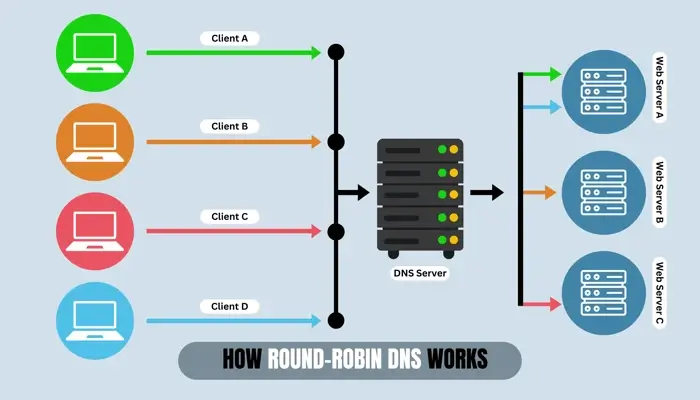What is Round-Robin DNS?
Managing web traffic efficiently is crucial for maintaining website performance in today’s digital landscape. As websites grow in popularity, distributing incoming traffic across multiple servers becomes essential to prevent overloading any single server. DNS round robin, or round-robin DNS, offers a straightforward solution by evenly distributing traffic across several servers.
While this approach is simple, it plays a key role in improving the reliability of web services. In this article, learn what round-robin DNS is, how it works, and how to implement it in DNS configurations.
What is DNS round robin?
Round-robin DNS is a simple technique for distributing traffic among servers hosting the same website or service. When a user tries to access a website, the domain name system (DNS) resolves the domain name to an IP address.
In a round-robin setup, the server has several different IP addresses associated with a single domain. Each time a user makes a DNS query, the server returns a different IP address in a circular sequence, thus directing the user's request to a different server.
An example of a round-robin configuration is as follows:
- User 1 asks for example.com, and the server sends them to IP 1.
- User 2 asks for example.com, and the server sends them to IP 2.
- User 3 asks for example.com, and the server sends them to IP 3.
- When User 4 asks, the process starts over, sending them back to IP 1.
This cycle continues, ensuring that each server gets equal traffic over time.
How round-robin DNS works
DNS round robin works without the need for special hardware or complex systems. It is managed through an authoritative DNS server, which resolves domain names into IP addresses. Each server behind the domain receives a unique IP address assignment. The DNS server cycles through these addresses as it responds to incoming queries.
The three key steps in round robin are a query, resolution, and address return.
- DNS Query: A user enters a domain name (e.g., example.com) in their web browser.
- DNS Resolution: The DNS resolver checks the local cache for the domain's IP address. If it does not find it, it sends a request to the authoritative DNS server.
- IP Address Return: The DNS server returns one of several IP addresses in a rotating order, sending the user’s request to a different server.

What is the purpose of the DNS round robin technique?
The primary purpose of round robin is to balance traffic across multiple servers and prevent any one server from becoming overloaded. This is particularly useful for websites that expect high volumes of traffic.
By distributing requests evenly, round robin helps maintain a smooth user experience, even during peak times. It offers improved performance since, with less strain on individual servers, the website can handle more visitors simultaneously. Furthermore, implementing this type of DNS doesn't require expensive hardware or advanced infrastructure. The system can scale without significant additional costs if multiple servers are able to handle the load.
Additionally, round robin offers increased availability. Multiple servers handling requests minimizes the risk of server failure causing downtime. If one server goes offline, the DNS server redirects traffic to another server in the loop.
How round robin helps load balancing
Load balancing is essential for websites and online services with high traffic demands. Round-robin DNS offers a straightforward approach to distributing traffic across several servers, which can help prevent any one server from becoming a bottleneck.
Without load balancing, all traffic would go to a single server, increasing the risk of crashes or slowdowns. Round-robin DNS addresses this issue by ensuring that no server receives an overwhelming number of requests at once. However, while effective for basic load balancing, round robin does not consider the server’s current load or capacity.
Limitations of DNS round robin
While round robin is an excellent tool for basic load balancing, it does have some limitations. DNS caching at both the client and resolver levels can cause uneven traffic distribution. When a user's device or a DNS resolver caches an IP address, it may repeatedly direct future requests to the same server, defeating the purpose of balancing the load.
Furthermore, round-robin DNS does not automatically detect the failure if a server goes offline. The system sends traffic to the offline server, leading to failed requests until a user manually removes the faulty IP address from the DNS configuration.
Round robin treats each request equally without considering a server's health or capacity. This means that if one server is underperforming or slow, traffic may still go to it, affecting the overall quality of the connection.
Advantages of DNS round robin
Despite its limitations, round-robin DNS offers several benefits for organizations that need a simple and cost-effective load-balancing solution.
- Ease of use. It is straightforward to set up. DNS records can be configured with multiple IP addresses for a single domain, and the system will handle the rest.
- Cost savings. By avoiding the need for dedicated load-balancing hardware or specialized software, this kind of DNS is a low-cost solution for distributing traffic.
- Scalability. Adding more servers to a round-robin configuration is simple. As a website grows and requires more resources, site managers can add additional servers to the DNS configuration without disrupting the system.
- Availability. Having multiple servers ensures that the website remains accessible even if one server fails. While manual intervention may be required to remove a failed server’s IP address, the system generally ensures continued availability.
Disadvantages of round robin
While round robin is helpful, it also comes with drawbacks.
- Inefficient traffic distribution. DNS caching can result in some servers receiving more traffic than others, leading to uneven load distribution.
- No failover mechanism. Round-robin DNS doesn’t automatically redirect traffic to healthy servers if a server goes down. The server must be manually removed from the DNS configuration.
- Limited to simple load balancing. DNS load-balancing round robin does not account for the individual load of servers. A server under heavy load might still receive traffic, potentially resulting in slower user performance.
DNS round robin in cybersecurity
While this type of DNS is primarily used for traffic management, it can also be beneficial or detrimental to cybersecurity.
Cyberattackers and round robin
Cybercriminals in the past have exploited this type of DNS for malicious purposes. One example is fast-flux techniques, where attackers frequently change IP addresses to hide malicious websites. This obfuscation technique makes it more difficult for security teams to track and block malicious sites.
Using a round robin setup with a short time-to-live (TTL) value for each IP address, attackers can quickly change the IP addresses associated with their domain, making it harder for defenders to catch and shut down the malicious servers.
Protecting against attacks
To protect against attacks that use round robin, organizations must implement monitoring and threat detection systems that can identify unusual traffic patterns. Additionally, more advanced load-balancing methods, such as those considering server health and load, can help mitigate the risks of overloading any particular server.
Frequently asked questions
What is DNS round robin used for?
DNS round robin is primarily used for load balancing. It helps distribute traffic across multiple servers by rotating through a list of IP addresses each time a user creates a DNS query.
Can round robin handle server failures?
No, DNS round robin doesn’t automatically detect or handle server failures. If a server goes down, the DNS server will continue to send traffic to it until it is manually removed from the rotation.
Does round-robin DNS work with all types of DNS records?
Round-robin DNS generally works with A records and AAAA records. However, it doesn’t work with CNAME records. Using CNAME records in round robin configurations can cause issues, especially with services like email, because they rely on accurate DNS resolution.
Can round robin distribute traffic evenly across servers?
Round robin attempts to distribute traffic evenly by rotating through a set list of IP addresses. However, due to DNS caching and the fact that clients may keep using the same IP address, traffic distribution might only sometimes be perfectly balanced.

